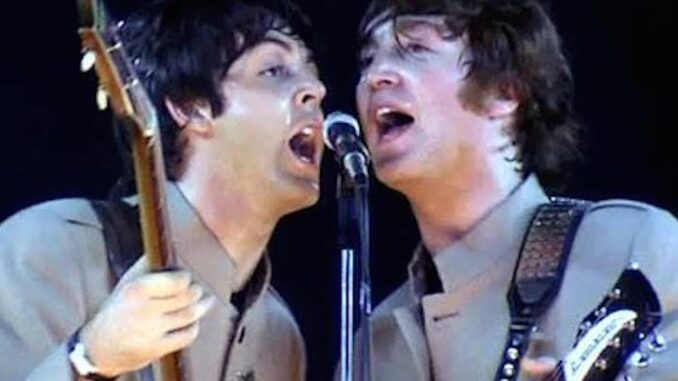
The Beatles, already sweeping the globe with their infectious melodies and charismatic presence, drew an enormous crowd that filled the sprawling Shea Stadium—then one of the largest stadiums in the United States—with an estimated attendance of over 55,000 fans. The excitement was palpable as thousands of teenagers, screaming and singing along, eagerly awaited the legendary British band’s arrival on stage.
The concert began with their energetic opener, “Twist and Shout,” a song that had become one of their signature hits. The raw power of John Lennon’s vocals, combined with the infectious beat and the band’s tight instrumentation, immediately electrified the audience. The choice of “Twist and Shout” as the opening song set the tone for an electrifying performance that would showcase the band’s dynamic stage presence and musical prowess.
Throughout the roughly 30-minute set, The Beatles performed a total of 12 songs, each contributing to an unforgettable musical experience. Following “Twist and Shout,” they played a series of hits that spanned their early catalog, including “She Loves You,” “I Want to Hold Your Hand,” “All My Loving,” and “Please Please Me.” The set list also featured live renditions of “I Saw Her Standing There,” “Boys,” “Long Tall Sally,” and “Roll Over Beethoven,” among others. Their repertoire combined energetic rock ‘n’ roll with charming pop melodies, captivating the massive audience from start to finish.
The concert was notable not only for its size but also for its groundbreaking nature. It was the first time a major stadium was used for a rock concert, paving the way for future large-scale live performances by legendary artists like The Rolling Stones, Led Zeppelin, U2, and many others. The logistical challenges of sound quality, crowd control, and stage setup at Shea Stadium prompted innovations in concert production that would influence the industry for decades.
Spectators reported that the sheer volume of the band and the crowd created an almost surreal atmosphere. The sound of thousands of screaming fans combined with the amplified music made for a deafening experience, but it also underscored the intense popularity of The Beatles at the height of Beatlemania. The stadium’s open-air environment amplified the band’s music, creating a monumental sound that resonated through the New York City skyline.
Photographs and footage from the concert show a band in their prime—George Harrison, Paul McCartney, John Lennon, and Ringo Starr—smiling, joking, and engaging with their fans despite the chaos of the crowd. The Beatles’ performance at Shea Stadium marked a turning point in live music, demonstrating that rock bands could command massive audiences in outdoor venues and that the concert experience could be scaled to stadium proportions.
Critics and fans alike hailed the Shea Stadium concert as a historic milestone. Music journalist Robert Shelton described it as “a defining moment in rock history,” highlighting how The Beatles managed to connect with such a large audience while maintaining their signature charm and musical excellence. The success of the concert boosted The Beatles’ popularity further and cemented their status as cultural icons of the 1960s.
In the aftermath, the concert at Shea Stadium became a blueprint for future stadium shows. Its legacy endures as a symbol of the power of music to unite massive crowds, and it marked the beginning of a new era where live performances could be as grand as the music itself. The Beatles’ performance on that summer day in 1965 remains a testament to their influence and the transformative impact they had on the music industry.
Today, the Shea Stadium concert is remembered not only for its historical significance but also for the infectious energy and groundbreaking spirit that defined the 1960s. It was a moment when a band from Liverpool proved that rock and roll could fill stadiums and captivate millions, setting the stage for future generations of musicians and fans alike.
Leave a Reply